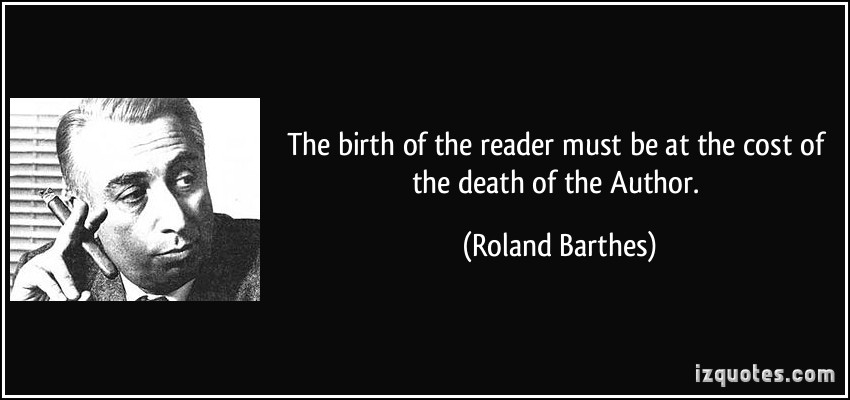In this way is revealed the whole being of writing: a text consists of multiple writings, issuing from several cultures and entering into dialogue with each other, into parody, into contestation; but there is one place where this multiplicity is collected, united, and this place is not the author, as we have hitherto said it was, but the reader. Roland Barthes—The Death of the Author
It was 1967 when Roland Barthes first pronounced the death of the author. It was a great idea, at the time, that the author’s biography and psychology were insufficient to explain their intentions for writing great works of art. Draining the text of the author’s ego allowed for the legitimacy of readers’ interpretations, and presented the wonderful idea that power rests, not in the hands of the few people who write something special, but in the hands of the many who thoughtfully engage with it. What’s more, the death of the author has been quite influential regarding the interpretation of digital media such as video games. We usually focus on what consumers do with them or how they are influenced by them rather than the intentions of the myriad nameless people are responsible for a game’s creation.
What I’ve found by studying Twine games is that they confound the belief that the author is dead!
This was 2012, and I hadn’t ever seen writing like that in a videogame. I’d grown up with games, but I’d never felt the presence of their authors. Games were, to me, cultural products similar to big-budget films: Obviously there were people involved in their design, but they never came through as individuals. And although by 2012, I was dimly aware of the existence of independent artists who made their presence as individual human beings felt through games, my experience had led me to believe that even those creators were mostly men, telling stories that were maybe interesting but not directly relevant to my life. Merritt Kopas—Video Games for Humans
It’s difficult to separate a Twine game from its author; and that, I think it part of its point, part of a Twine game’s reason for being! Take one of Kopas’s own games—Consensual Torture Simulator—that my colleague Kendall Gerdes asked me to play not long ago. The game is challenging, not in the way most videogames are described, through rhetorics of proficiency or skill. Instead, it challenges the player because of the ethical, moral, and psychological choices that need to be made in order to maintain a tenuous balance between a loved one’s desire and the participants’ well-being! Or, as Kendall said when we spoke about our experiences playing the game, “It certainly gives a new take on videogame violence!”
Meditating on what motivates an author to create a Twine game reminds us that the power of the author is not yet depleted—the author yet lives. It makes us remember that digital authors have good stories to tell. Although most human experiences have happened before, not all of them have been shared by the power that mediated communication can provide. The author still has the ability to challenge people to experience something new, or to present something familiar in a new light. Kopas’s CTS proves it!
Want to read another meditation on tension between author and reader? Click here to find one by Bill Adams, where I originally found the image above!



Interesting take, JB! Kopas’s remark about feeling the presence of the author is pretty compelling, though I’d argue that this feeling of presence still depends structurally on the author’s absence–meaning that whatever “encounter” takes place, it takes place in (a game’s) writing. CTS is a really rich example of this, too, since you play the game as the partner who has “all” the power, who in a sense authors the experience of her (your) companion. The emotional and energetic attrition you undergo (I mean really “you” the player!) undermines, and in a way underwrites, that power though. The mutual construction of meaning in the world of CTS has a lot of vectors beyond authorial intent.